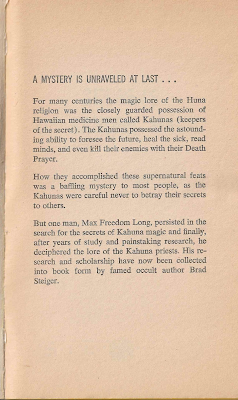"Just to give a glimpse of his class consciousness, Brigham never met Hawaiian scholar Mary Kawena Pukui, though their paths crossed at the museum for a few years ... [S]he already had served as a source for books by Martha Beckwith and Laura Green because of her deep knowledge of Hawaiian ways. Yet this man of science who was working on a manuscript about Hawaiian religion did not interview a woman who was trained by her grandmother, a kahuna in the Pele line.""He especially didn’t like Hawaiians. He called Queen Lili‘uokalani a “squaw.” In a letter he referred to the Queen as a “she devil,” said he “hoped she would be shot or hanged,” and wrote that the Hawai-ians’ attempt to restore the monarchy was “so that the n-gger might reign supreme.”"
So we find yet another dead-end of racism and cultural appropriation in the classic paranormal genre. These quickie cash-in books were nothing new for Steiger, who profiled many, many New Age hucksters like Long over the course of his prolific career, always with a sympathetic slash promotional gloss. The inconvenient facts of Long's dubious research didn't stop Steiger from writing further books on Huna, but we'll give Makana Risser Chai the final word on the original source of all this unseemly business:
"There is strong evidence that Long and Brigham did not meet at all, because none of the stories attributed to Brigham were in his own works. Even if they did meet, Brigham was not a reliable source on Hawaiian religion or kāhuna. Any quotes attributed to Brigham sourced from Long’s books are not credible."
Aloha for now, Brad, Max, and William, and may we meet again under better circumstances. Secrets of Kahuna Magic is available to read and download at archive dot org.
Award Books, 1971









No comments:
Post a Comment